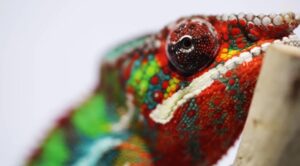Chameleons require water daily, either through misting or a drip system. Always ensure consistent water availability for their health.
Chameleons thrive when their environment mimics their natural habitat. Owners need to provide them with appropriate water access, as these reptiles typically do not drink from a water bowl. In the wild, chameleons hydrate by licking dew or raindrops from leaves, which is why misting the leaves in their enclosure or providing a dripping system that replicates falling water droplets is crucial.
This not only prevents dehydration but also aids in their overall wellbeing. Maintaining this routine daily helps in keeping chameleons healthy, as continuous water provision is vital to avoid stress and potential health risks in these sensitive creatures.
Chameleon Hydration Basics
Understanding the hydration needs of chameleons is crucial for their overall health and well-being. Like all living creatures, chameleons require water to survive, but their needs and methods of hydration are unique. They don’t sip from a water bowl like a cat or a dog; instead, they lick droplets of water from leaves. This behavior mirrors their natural habitat and instinctual practices.
The Importance Of Hydration For Chameleons
Offering water regularly to your chameleon supports their physiological functions. It helps in digestion, aids in shedding, and ensures proper kidney function. A properly hydrated chameleon will also boast vibrant skin colors, a telltale sign of good health. Experts recommend misting your chameleon’s enclosure twice a day as this not only provides water droplets for them to drink but also maintains the proper humidity levels critical for their health.
Signs Of Dehydration In Chameleons
Be vigilant for signs that your chameleon may be dehydrated:
- Sunken eyes: A clear indication of lack of water.
- Dry or flaky skin: Signifies hydration issues.
- Weakness: A dehydrated chameleon may appear lethargic.
Regularly monitor for these symptoms to ensure your chameleon stays hydrated and healthy.
Watering Techniques For Chameleons
Chameleons need water to stay hydrated, just like other pets. But their needs are unique. They don’t drink from a water bowl in the wild. They get moisture from dew and raindrops on leaves. In captivity, we must mimic this environment. Offering water the right way is key for a chameleon’s health.
Misting Systems For Enclosures
Automated misting systems replicate natural rainfall. They spray a fine mist at scheduled intervals. This lets chameleons drink from droplets that form on surfaces. It also maintains humidity levels. When setting up, ensure multiple nozzles cover the enclosure evenly.
- Keeps air moist
- Encourages natural drinking behavior
- Helps with shedding process
Dripping Water Methods
A drip system simulates dewdrops falling from leaves. A container is placed above the enclosure. It allows water to drip down slowly. Where the drops land, chameleons can lick them up. Make sure the dripping rate is slow. Place a plant beneath to catch drips, as chameleons prefer to drink from leaves.
- Mimics dewdrops
- Encourages hydration
- Simple to set up
Providing Water Bowls: Pros And Cons
| Pros | Cons |
|---|---|
| Easy to refill | Not a natural way to drink for chameleons |
| Lowers costs | Can be ignored by chameleons |
| Can add moisture to the air | Risk of bacterial growth |
Some keepers use water bowls. Yet, chameleons might not recognize still water as a source. If you choose this way, change water daily. Place it where your chameleon passes often. But watch out for signs of dehydration. It suggests your chameleon is not using the bowl properly.
Frequency Of Watering
Chameleons need water just like any other living creature, but unlike our pets that can drink from a bowl, these colorful lizards take up water differently. Understanding the frequency of watering is crucial for a chameleon’s health. With unique methods of hydration, knowing how to provide water and how often can make all the difference to your scaly friend’s well-being.
Daily Hydration Needs
Chameleons are not your average pet when it comes to drinking water. Their drinking habits are as unique as their vibrant color patterns. Despite their distinct needs, they require water every day. To mimic the dew and droplets found in their natural habitat, daily misting is essential. Creating a rain system replicates rainfall and encourages drinking. Always use clean and fresh water to avoid any health issues.
| Age of Chameleon | Watering Frequency |
|---|---|
| Youths | Twice a day |
| Adults | Once a day |
Adjusting Water Supply With Environmental Changes
Chameleons are sensitive to their environment. Misting frequency may need adjusting based on the humidity and temperature of their surroundings. In a more humid climate, less frequent misting may be adequate. Conversely, a dryer environment calls for more frequent misting. Always observe your chameleon for signs of dehydration such as sunken eyes or lack of energy, and adjust accordingly.
- Summer: More misting to combat heat.
- Winter: Less misting if humidity rises.
Remember, a hygrometer is your best friend to keep track of the humidity levels. Keep it between 50-70% for optimal health. The goal is to provide a comfortable and hydrating environment that caters to your chameleon’s health year-round.
Monitoring Chameleon Hydration
Monitoring Chameleon Hydration is crucial for keeping your pet healthy. These remarkable reptiles possess unique water needs. To ensure your chameleon thrives, understanding how to maintain proper hydration is key. Let’s dive into how to monitor their water intake effectively.
Checking For Adequate Water Intake
Chameleons don’t drink from a water bowl like other pets. They prefer water droplets on leaves, mimicking their natural habitat. To check if your chameleon is drinking enough, observe these factors:
- Dew on leaves: Mist the enclosure twice daily. Look for your chameleon licking droplets.
- Humidity levels: Maintain 50-70% humidity. Use a hygrometer to monitor.
- Watering system: A dripping system or mister can help. Ensure it runs regularly.
Behavioral Cues Of Proper Hydration
A well-hydrated chameleon showcases specific behaviors. Observe these signs:
| Behavior | Hydration Indicator |
|---|---|
| Clear urates: | White or light yellow waste shows good hydration. |
| Eye Bulging: | Chameleons bulge their eyes to clean them, indicating hydration. |
| Active and Alert: | An energetic chameleon is likely well-hydrated. |
Troubleshooting Common Hydration Issues
Chameleons need a balance in hydration for optimal health. Discovering the right amount of water for your chameleon can be a tricky process. Common hydration issues may arise, but with the right knowledge, you can troubleshoot them effectively.
Dealing With Overhydration
Overhydration, though less common, can happen. Signs include swollen eyes and lethargy. Prevent this by:
- Monitoring water intake
- Adjusting misting sessions
- Ensuring proper drainage in the habitat
React by reducing misting frequency and consulting a veterinarian if symptoms persist.
What To Do If Your Chameleon Isn’t Drinking
Noticing your chameleon ignoring water sources can be alarming. Address it with these steps:
| Issue | Solution |
|---|---|
| Dehydration Signs | Offer water through a dropper or misting to encourage drinking. |
| Water Source Visibility | Ensure that water sources like drippers are visible and accessible. |
| Checking for Illness | Look for other signs of illness and consult a vet if concerned. |
Remember, patience and observation are key to resolving these issues. Keep the habitat clean and ensure a stress-free environment for your pet.
Enhancing Hydration Through Diet
Caring for a chameleon means ensuring they get enough water. But did you know their food can also keep them hydrated? Let’s explore how diet plays a vital role in keeping your chameleon well-hydrated.
Hydration-boosting Foods
Chameleons can absorb moisture through what they eat. Foods rich in water content are excellent for hydration. Here’s a list of hydration-boosting foods:
- Fruits: Serve slices of watermelon, oranges, and strawberries.
- Vegetables: Offer bits of cucumber, bell peppers, and leafy greens.
- Live Prey: Feed moisture-rich insects like hornworms and dubia roaches.
Supplements To Support Hydration
Dietary supplements can also enhance your chameleon’s water intake. Use these carefully:
| Supplement | Benefit |
|---|---|
| Calcium With Vitamin D3 | Supports water and electrolyte balance. |
| Multivitamins | Promotes overall health, aiding in better hydration levels. |
Remember, always consult a vet before adding supplements to your chameleon’s diet.
Frequently Asked Questions On How Often Do You Give A Chameleon Water?
How Do I Know If My Chameleon Is Getting Enough Water?
Check your chameleon for signs of hydration: clear, moist eyes; regular skin shedding; and normal feces. Offer daily misting or a dripping water system to ensure adequate water intake.
How Should I Give My Chameleon Water?
Provide water to your chameleon by misting plants in their enclosure twice daily. Offer dripping water from a leaf or a slow-drip water system, as chameleons prefer drinking moving water. Ensure the humidity remains appropriate for their species to support adequate hydration.
How Do You Give A Chameleon Fluids?
To give a chameleon fluids, use a syringe or dropper to gently administer water or electrolyte solution directly into its mouth. Ensure the chameleon is comfortable, and offer fluids slowly to prevent stress or aspiration.
Do Chameleons Drink Water From A Bowl?
Chameleons do not typically drink from a bowl; they prefer licking water droplets off leaves. To hydrate them, mist their habitat regularly.
Conclusion
Caring for a chameleon involves understanding its unique needs, including hydration. Regular misting sessions are crucial, usually daily. Supply clean water through a dripper or fogger to mimic their natural environment. Remember, each reptile’s requirements may vary, so monitor your pet’s health and adjust accordingly.
Stay attentive, and your chameleon will thrive under your diligent care.

